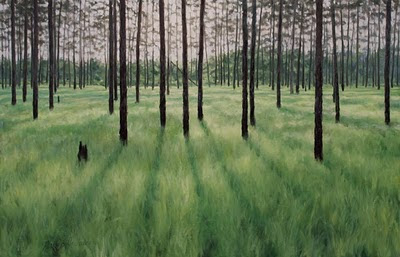Shining Rocks Wilderness, Pigsah National Forest
Landscape painting once had a rich dialogue with landscape design. The English landscape garden, for example, was greatly influenced by paintings. This rich connection hardly exists today. But painter Philip Juras might have something to say about that. Formally trained as both a painter and a landscape architect, Juras is the perfect link between landscape painting and design. His large scale paintings capture the beauty of specific ecological communities. Juras paints primarily remnant native landscapes. Like the Manahatta project in New York, Juras’ work focuses on depicting specific ecological communities as they may have looked before European settlement.
His canvases are large and luminous, capturing the feeling of space as light moves across it. He deftly balances abstraction and ecological specificity. The compositions are serene yet teeming with life. Juras most recent series are paintings used to illustrate a book on naturalist William Bartram’s travels through the American South.
I first met Philip when I was in graduate school at the University of Georgia. My professor and native plant expert Darrel Morrison developed a class that took students to remnant virgin landscapes around the Southeast. Juras joined us on some of those trips. The landscapes we witnessed changed the way I thought about design. The complexity and majesty of these spaces were unlike any other human disturbed forest or meadow I had experienced. The patterns created by the mature plant communities were strong, legible, and distinct, a offering a storehouse of ideas for modern design. Juras’ paintings recall these landscapes.
To see more about Philip's work, visit his website: http://www.philipjuras.com/index.htm







Wow, beautiful work, what inspiration!
ReplyDelete((bLog preserve?)) Love the luminous quality, and wisps of fog rising off the river.
ReplyDeleteTalented artists help us all see. Those paintings capture the way I "see" old landscapes in modern Illinois. I'm so happy you've mentioned William Bartram, my favorite old-time Quaker naturalist. I've heard that some of what he thought was wilderness was actually managed landscape, as evidenced by a greater than expected distribution of chestnut trees. Do you know if this is true?
ReplyDeleteHa, Blog Reserve . . . must have been a Freudian Slip.
ReplyDeleteAdrian,
ReplyDeleteI have not heard that, but remember you mentioning the fact that much of what we thought was wilderness was actually managed by Native Americans. I'd love to read more about that . . . do you remember where you came across that interesting fact?